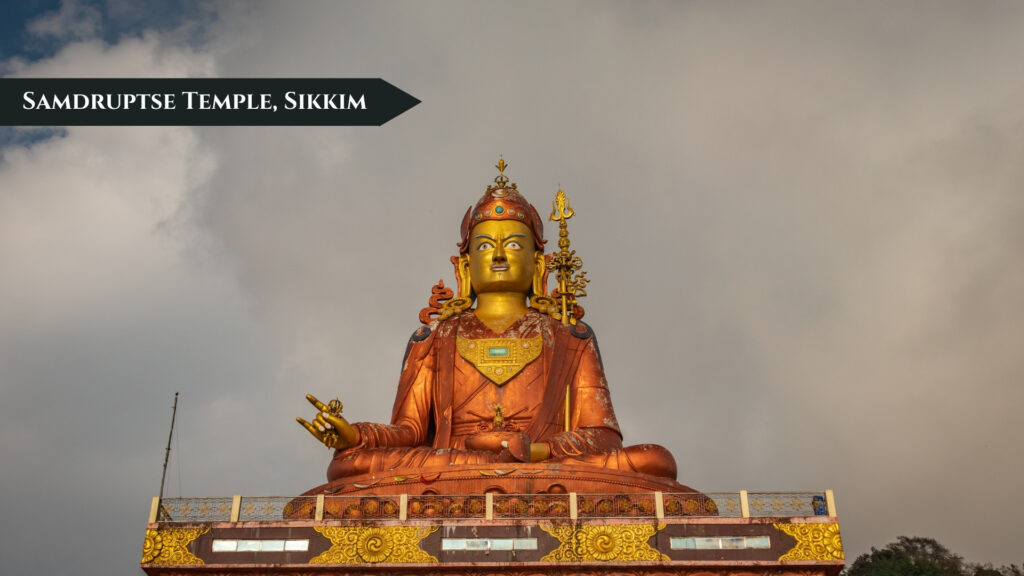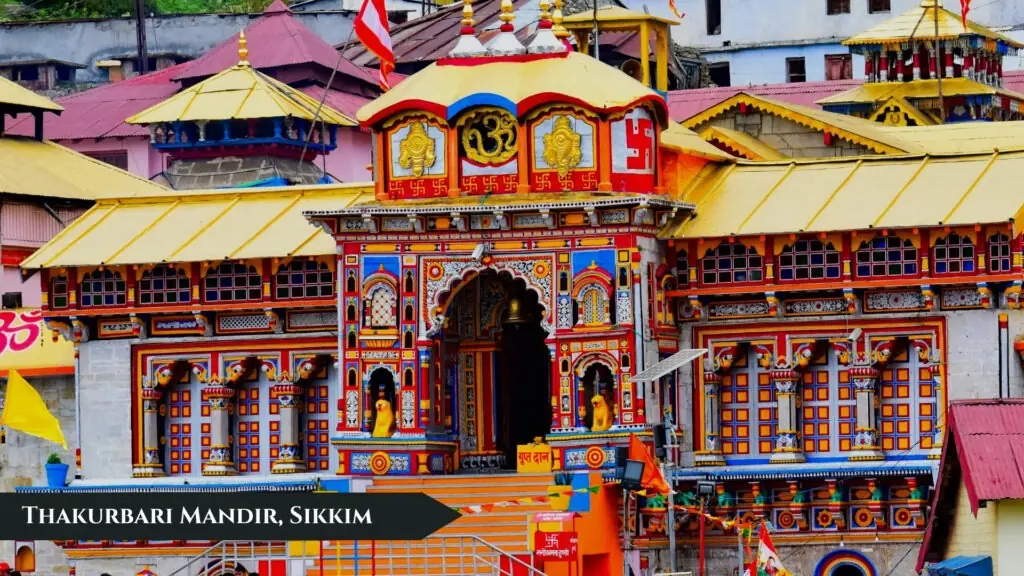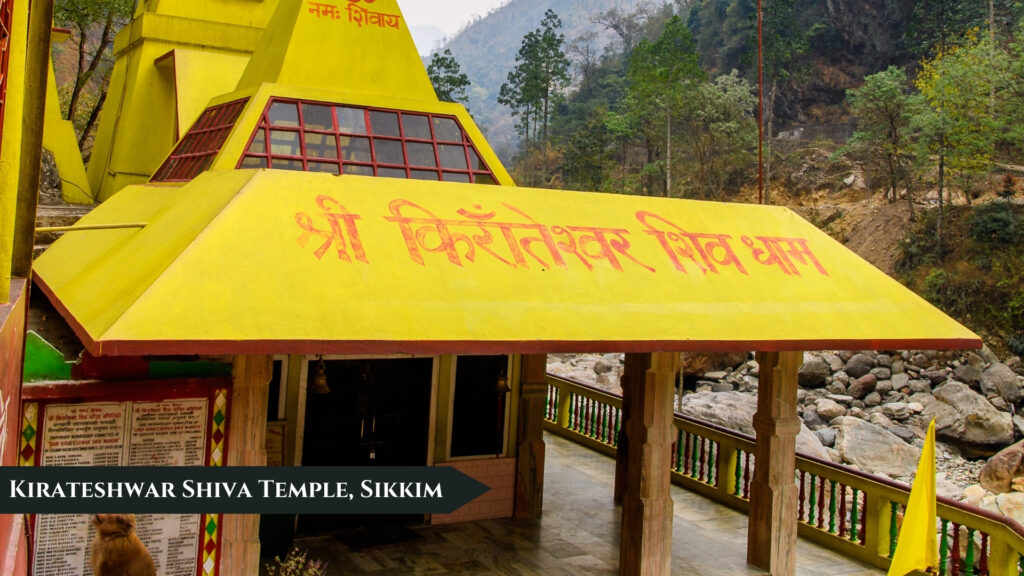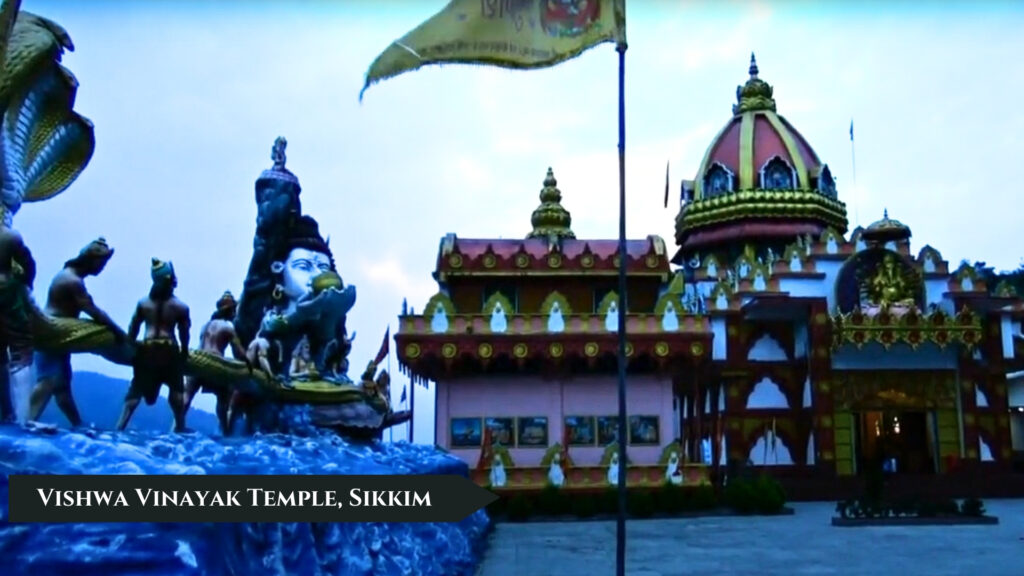Samdruptse Temple in Sikkim is one of the many hidden gems the state has. This majestic temple, known for its towering statue of Guru Padmasambhava, is a symbol of peace and spirituality. On my previous visit to Namchi, I had to visit this awe-inspiring temple that the locals of Sikkim had told me about.
In this blog, I share my experience of the time I visited the Samdruptse Temple in Sikkim and all the stories that I have heard about the place.
Location Of Samdruptse Temple
The Samdruptse Temple is located in Namchi, the district headquarters of South Sikkim. This temple is perched on a hill, offering panoramic views of the surrounding valleys and distant snow-capped mountains.
Namchi is approximately 75 kilometers from Gangtok, the capital city of Sikkim. The statue of Guru Padmasambhava at Samdruptse is the tallest in the world, standing at an impressive 118 feet, making this temple a significant landmark.
Samdruptse To Namchi Distance
The distance between Samdruptse Hill and Namchi is 7 kilometers. State Buses and private/shared cabs are available from Gangtok to Namchi. Samdruptse Temple has also been referred to as the Samdruptse Hill locally.
How To Reach Samdruptse Temple
If you are planning on going to Samdruptse, you have to reach Namchi first. Namchi is well-connected by road and can be reached from various parts of Sikkim and West Bengal. The most convenient way to reach Namchi is to first come to Gangtok and then hire a private taxi or take a shared cab to Namchi.

The distance from Gangtok to Namchi is approximately 75 kilometers. You can also use the state buses to reach Namchi and then finally travel to Samdruptse Temple.
What Is The Main Attraction Of Samdruptse Temple
If you are traveling to Sikkim, do not miss an opportunity to visit the Samdruptse Temple. The main attraction of Samdruptse is the massive statue of Guru Padmasambhava, which stands at 118 feet. The statue is coated with shimmering copper and holds a serene expression that exudes peace and tranquility. The temple offers breathtaking views of the Himalayan range and the lush green forests below.
Samdruptse Temple Architecture
Here’s an overview of the architecture and features of Samdruptse Temple:
Architectural Style
- Buddhist Influence: The architecture of the temple showcases a blend of traditional Buddhist styles, reflecting the local culture and religious practices.
- Grand Statue: The temple is dominated by the grand statue of Guru Padmasambhava, also known as Guru Rinpoche, who is revered as the patron saint of Sikkim.
Structural Elements
- Main Shrine: The main sanctum houses the giant statue of Guru Padmasambhava. The sanctum is simple yet profound, focusing on the spiritual presence of the Guru.
- Prayer Hall: The temple has a spacious prayer hall where devotees gather for meditation and ceremonies. This area is peaceful and designed to facilitate spiritual practices.
- Entrance and Courtyard: The temple features a grand entrance leading into a beautifully landscaped courtyard. The courtyard is often used for community gatherings and festivals.
Decorative Elements
- Intricate Carvings: The temple walls and pillars are adorned with intricate carvings and motifs depicting various aspects of Buddhist mythology.
- Sculptures: Statues and sculptures of different deities and mythological figures are placed around the temple premises, adding to its spiritual ambiance.
- Prayer Flags: Reflecting the Buddhist practices in the region, the temple surroundings are adorned with colorful prayer flags that add to the serene atmosphere.
Samdruptse Temple Information
The temple holds significant spiritual value for the locals and is a popular destination for tourists seeking peace and tranquility. The temple is not only a place of worship but also a spot to appreciate the natural beauty of Sikkim.
Best Time To Visit Samdruptse Temple
The best time to visit Samdruptse Temple is during the months of March to June and September to November. During these months, the weather is pleasant, and the skies are clear, providing the best views of the Himalayan range. The months of December to February can be quite cold, and the area may experience snowfall, adding a different charm to the place.
You can also refer to the Weather In Sikkim article on my site to know more about the best time to visit Sikkim.
Samdruptse Temple History and Local Beliefs
According to local beliefs, the Samdruptse Hill is a wish-fulfilling hill, and the temple was constructed to honor Guru Padmasambhava. The locals believe that the Guru watches over the region and blesses the people with peace and prosperity.

The temple’s history is rooted in the spiritual traditions of the region, and it is considered a powerful place for prayer and meditation. Refer to my YouTube Channel for detailed insights upon the Samdruptse Temple in Sikkim.
The locals believe that offering prayers at Samdruptse Temple helps in seeking blessings for good health, prosperity, and peace. The temple is also associated with various local legends and stories that add to its mystical charm.
Other Temples In Sikkim
Here below, I have added some other famous temples in Sikkim that you can look forward to visiting. I have a blog dedicated to famous temples in Sikkim that covers almost all the temples of the state.
Ganesh Tok

Ganesh Tok is a small but significant temple dedicated to Lord Ganesh. Offering panoramic views of Gangtok and the surrounding mountains, this temple is a peaceful spot for devotees and tourists to seek blessings and enjoy the natural beauty of Sikkim.
Hanuman Tok

Situated in rich forests, Hanuman Tok is a reputed temple dedicated to Lord Hanuman. Visitors can climb the stairs to the temple and marvel at the amazing vistas of Gangtok and the Himalayas, making it a popular destination for spiritual seekers and nature enthusiasts alike.
Baba Harbhajan Mandir

Baba Harbhajan Mandir is a unique temple dedicated to an Indian army soldier, Baba Harbhajan Singh. Believed to protect and bless the soldiers guarding the Indo-China border, this temple attracts devotees who come to pay homage to the spirit of the reputed soldier and seek his blessings for protection and well-being. Baba Harbhajan Mandir is situated in the East Sikkim region of the state of Sikkim.
Thakurbari Temple

Thakurbari Temple is a prominent Hindu temple in Sikkim dedicated to Lord Krishna. Known for its beautiful architecture and peaceful surroundings, the temple is a place of worship and pilgrimage for devotees from across the state and beyond.
Kirateshwar Temple

Kirateshwar Temple is dedicated to Lord Shiva and is believed to be the spot where Arjuna, from the Mahabharata, received the divine weapon, Pashupatastra. Surrounded by rich greenery and overlooking the confluence of two rivers, this temple holds great religious significance and attracts devotees seeking blessings and solace.
Vishwa Vinayak Temple

Vishwa Vinayak Temple is a reputed shrine dedicated to Lord Ganesha, the remover of obstacles. Situated in peaceful surroundings, the temple provides devotees with a peaceful space for prayer and reflection, as well as stunning views of the surrounding mountains and valleys.
FAQs Related To Samdruptse Temple
What is the significance of Samdruptse Temple?
Samdruptse is a significant Buddhist shrine known for its massive statue of Guru Padmasambhava, symbolizing peace and spiritual protection.
Where is Samdruptse Temple located?
The temple is located in Namchi, South Sikkim, approximately 75 kilometers from Gangtok.
What is the height of the statue at Samdruptse Temple?
The statue of Guru Padmasambhava at Samdruptse Temple stands at an impressive 118 feet.
What is the best time to visit Samdruptse?
The best time to visit is during the months of March to June and September to November for clear skies and pleasant weather.
How can one reach Samdruptse Temple?
The temple can be reached via road from Gangtok. The nearest airport is Bagdogra in West Bengal, from where you can take a taxi to Gangtok and then proceed to Namchi.
Is there an entry fee for Samdruptse Temple?
No, there is no entry fee for visiting the temple.
What facilities are available for visitors at the temple?
Basic facilities such as restrooms, drinking water, and a resting area are available. Additionally, nearby shops and eateries provide refreshments and religious offerings.
Are there any special rituals performed at Samdruptse Temple?
Daily prayers and meditation sessions are conducted, and special rituals are performed during important Buddhist festivals.
Is photography allowed inside Samdruptse Temple?
Photography is generally allowed in the temple premises, but it’s advisable to check with the temple authorities regarding any specific restrictions.



